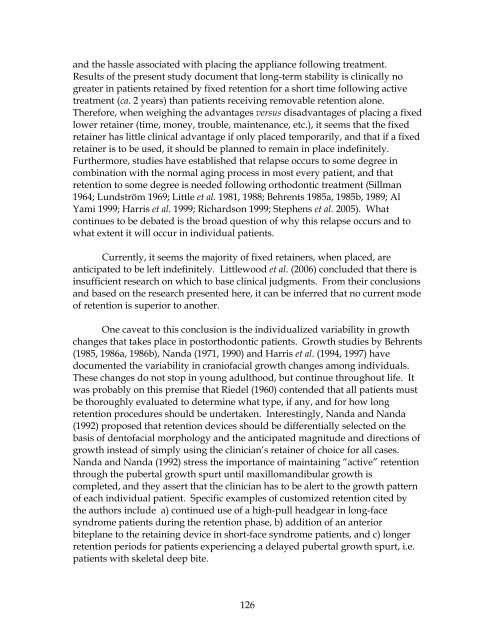EFFICACY OF TEMPORARY FIXED RETENTION FOLLOWING ...
EFFICACY OF TEMPORARY FIXED RETENTION FOLLOWING ...
EFFICACY OF TEMPORARY FIXED RETENTION FOLLOWING ...
Create successful ePaper yourself
Turn your PDF publications into a flip-book with our unique Google optimized e-Paper software.
and the hassle associated with placing the appliance following treatment.<br />
Results of the present study document that long-term stability is clinically no<br />
greater in patients retained by fixed retention for a short time following active<br />
treatment (ca. 2 years) than patients receiving removable retention alone.<br />
Therefore, when weighing the advantages versus disadvantages of placing a fixed<br />
lower retainer (time, money, trouble, maintenance, etc.), it seems that the fixed<br />
retainer has little clinical advantage if only placed temporarily, and that if a fixed<br />
retainer is to be used, it should be planned to remain in place indefinitely.<br />
Furthermore, studies have established that relapse occurs to some degree in<br />
combination with the normal aging process in most every patient, and that<br />
retention to some degree is needed following orthodontic treatment (Sillman<br />
1964; Lundström 1969; Little et al. 1981, 1988; Behrents 1985a, 1985b, 1989; Al<br />
Yami 1999; Harris et al. 1999; Richardson 1999; Stephens et al. 2005). What<br />
continues to be debated is the broad question of why this relapse occurs and to<br />
what extent it will occur in individual patients.<br />
Currently, it seems the majority of fixed retainers, when placed, are<br />
anticipated to be left indefinitely. Littlewood et al. (2006) concluded that there is<br />
insufficient research on which to base clinical judgments. From their conclusions<br />
and based on the research presented here, it can be inferred that no current mode<br />
of retention is superior to another.<br />
One caveat to this conclusion is the individualized variability in growth<br />
changes that takes place in postorthodontic patients. Growth studies by Behrents<br />
(1985, 1986a, 1986b), Nanda (1971, 1990) and Harris et al. (1994, 1997) have<br />
documented the variability in craniofacial growth changes among individuals.<br />
These changes do not stop in young adulthood, but continue throughout life. It<br />
was probably on this premise that Riedel (1960) contended that all patients must<br />
be thoroughly evaluated to determine what type, if any, and for how long<br />
retention procedures should be undertaken. Interestingly, Nanda and Nanda<br />
(1992) proposed that retention devices should be differentially selected on the<br />
basis of dentofacial morphology and the anticipated magnitude and directions of<br />
growth instead of simply using the clinician’s retainer of choice for all cases.<br />
Nanda and Nanda (1992) stress the importance of maintaining “active” retention<br />
through the pubertal growth spurt until maxillomandibular growth is<br />
completed, and they assert that the clinician has to be alert to the growth pattern<br />
of each individual patient. Specific examples of customized retention cited by<br />
the authors include a) continued use of a high-pull headgear in long-face<br />
syndrome patients during the retention phase, b) addition of an anterior<br />
biteplane to the retaining device in short-face syndrome patients, and c) longer<br />
retention periods for patients experiencing a delayed pubertal growth spurt, i.e.<br />
patients with skeletal deep bite.<br />
126
















